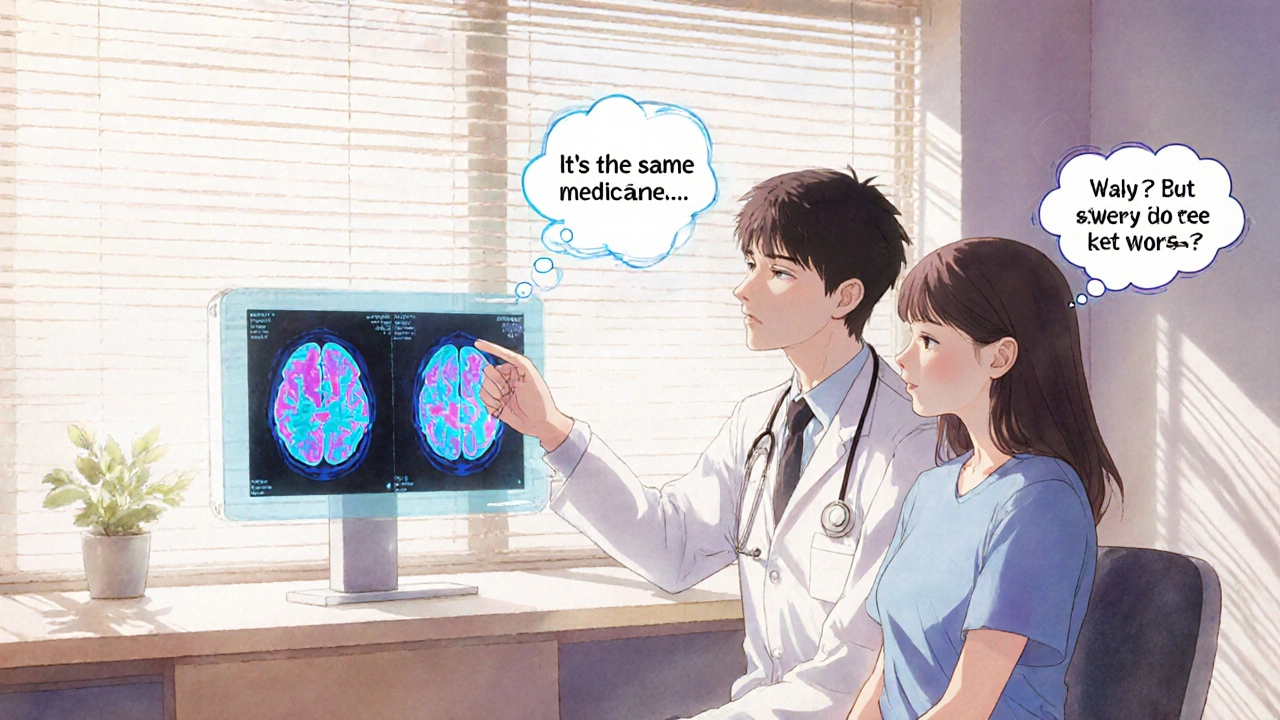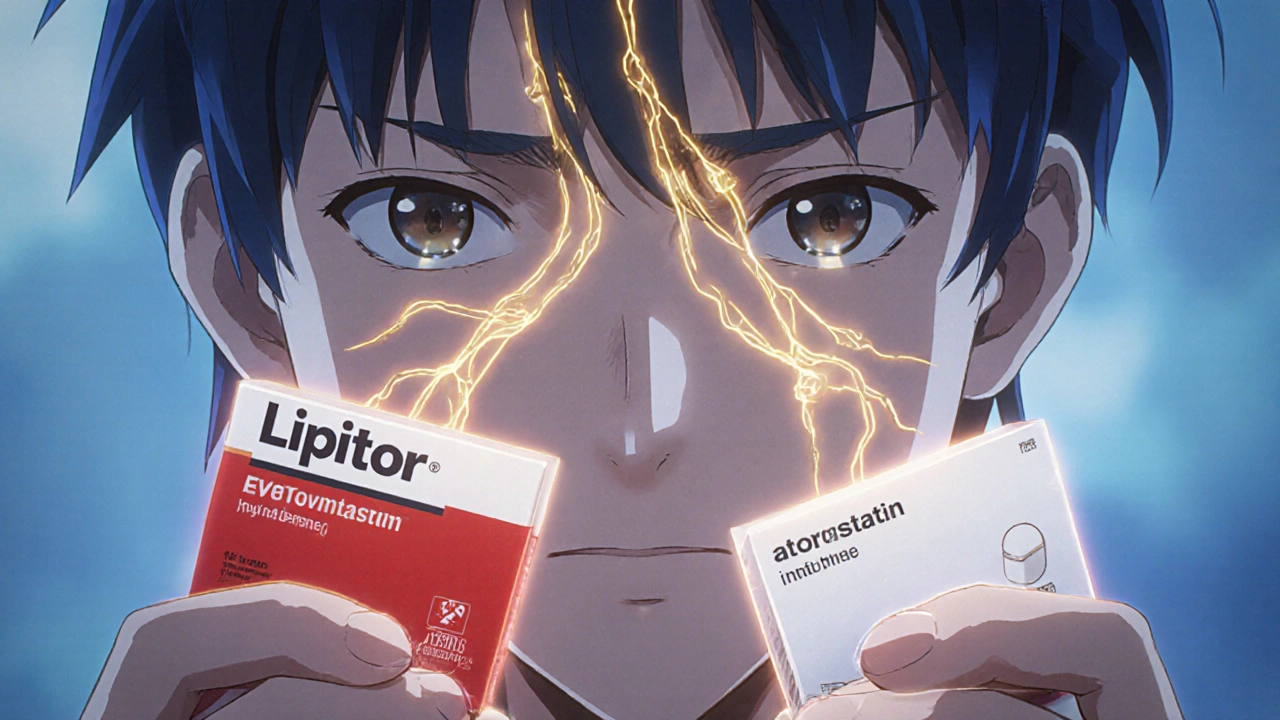When you switch from a brand-name drug to a generic, your body doesn’t change-but your mind might. And that’s where things get complicated.
Two pills can have identical chemicals, the same dosage, the same manufacturer, and still feel completely different to the person taking them. One is labeled "Lipitor," the other "atorvastatin." The price? One costs $4.83 a pill. The other? Eight cents. But if you believe the cheaper one won’t work, your brain might make sure it doesn’t.
This isn’t superstition. It’s science. And it’s happening to millions of people every day.
The Mind That Makes Medicine Work
The placebo effect isn’t about fake healing. It’s about real biology triggered by belief. When you expect a pill to help, your brain releases natural painkillers, lowers stress hormones, and even changes how your nerves fire. fMRI scans show the dorsolateral prefrontal cortex-the part of your brain tied to expectation-lights up 27% more when you think you’re taking a brand-name drug, even if it’s just sugar.
In one study, people given identical placebo pills were told one was a brand-name painkiller and the other a generic. The "brand" group reported 38% more pain relief. The pills were the same. The only difference? The label.
This effect isn’t weak. For painkillers, the gap between brand-labeled and generic-labeled placebos is as strong as the difference between a placebo and real ibuprofen. For antidepressants, patients on generic-labeled sertraline are 22% more likely to quit because they feel it’s "not working," even though their blood levels match those on the brand version.
Why Generics Feel Different (Even When They’re Not)
Generics are required by the FDA to be bioequivalent to brand-name drugs. That means they deliver the same amount of active ingredient into your bloodstream within the same time frame-within 80% to 125% of the brand’s performance. That’s not close. That’s the same.
So why do people swear their blood pressure spiked after switching from brand-name lisinopril to the generic? Or their anxiety got worse after switching from Lexapro to escitalopram? In some cases, yes, there are minor differences in inactive ingredients-fillers, dyes, coatings. But these rarely affect how the drug works.
More often, it’s the change in appearance. A pill that was once blue and oval becomes white and round. A capsule that used to say "Pfizer" now says "Mylan." Your brain notices. And if you’ve been told generics are "inferior," your mind starts looking for proof.
One study found that when generic manufacturers changed the color or shape of their pills, discontinuation rates jumped by nearly 30%. Patients didn’t report side effects-they just felt the medicine wasn’t working anymore. The drug hadn’t changed. Their expectations had.
The Cost-Expectation Trap
There’s a powerful link between price and perceived effectiveness. In a famous experiment, healthy volunteers were given fake painkillers labeled either $2.50 or $0.10. The expensive ones reduced pain by 64% more-even though they were identical. Your brain assumes expensive = better. It’s a shortcut we’ve learned from advertising, from packaging, from decades of marketing.
That’s why the $1.4 billion annual cost of unnecessary brand-name prescriptions exists. People aren’t paying more because the drug works better. They’re paying more because they believe it does.
And it’s not just about money. It’s about identity. Taking a generic can feel like accepting a lower standard of care. Some patients say things like, "I don’t want to take the cheap stuff," even when they’re on fixed incomes. The stigma is real. And it’s hurting their health.

Nocebo: When Expectations Backfire
The flip side of the placebo effect is the nocebo effect-when expecting harm causes harm. In statin trials, patients told they were taking a generic reported muscle pain at nearly four times the rate of those told they were taking a brand-name drug-even when they were all getting placebos.
One patient in a 2019 case report stopped taking generic escitalopram after developing "worse anxiety." Blood tests showed the same drug levels as before. The only change? The label. The patient didn’t have a chemical problem. They had a belief problem.
Doctors see this all the time. A patient says, "I can’t take the generic. It makes me tired." But when you ask, "Did you know this is the same medicine?"-they often say, "No. I just thought it was cheaper so it must be weaker."
What Doctors Can Do (And What They Should)
Most providers don’t talk about this. They assume if the science checks out, the patient will be fine. But that’s not how the human brain works.
A 2021 study in JAMA Internal Medicine showed that a simple 3-minute conversation cuts nocebo responses by nearly half. Here’s what works:
- Explain the FDA’s rules. "The FDA requires generics to be just as effective as the brand. They’re held to the same strict standards."
- Acknowledge the feeling. "Some people notice a difference in how they feel-even if the medicine is the same. That’s not because it’s weaker. It’s because your brain is used to the old pill."
- Give time. "Give it two weeks. Your body and your mind need to adjust. If you still feel off, we’ll talk again."
That’s it. No jargon. No lectures. Just clear, calm facts with empathy.
Doctors who use this approach see 32% higher adherence to generics. Patients don’t feel talked down to. They feel heard.

What Patients Can Do
If you’ve switched to a generic and feel something’s off, don’t assume it’s the drug. Ask yourself:
- Did the pill look different? (Color? Shape? Size?)
- Was I told this was "just as good," or did it feel like I was being pushed into it?
- Do I believe generics are inferior? Where did that belief come from?
Give it two weeks. Track your symptoms. Talk to your pharmacist. They see this every day.
If you’re still uneasy, ask your doctor to switch back-temporarily. But don’t quit because you feel worse. You might be feeling your expectations, not the medicine.
The Bigger Picture
Generics save the U.S. healthcare system over $300 billion a year. That’s money for cancer drugs, mental health services, insulin for people who can’t afford it.
But if we keep letting psychology undermine them, we’re throwing away those savings. We’re letting marketing, not science, dictate who gets treated.
The FDA is now requiring generic manufacturers to keep pill appearance consistent to reduce confusion. The European Union is spending €2.4 million on patient education programs. And a digital tool called the "Expectation Modulation Protocol" is showing 53% fewer nocebo reactions in clinical trials.
This isn’t about tricking people. It’s about aligning belief with reality.
What’s Next?
The next big step? Making expectation management part of standard care. Not a bonus. Not a nice-to-have. A requirement.
Imagine a world where every time you get a generic, you get a short, clear explanation-not just a receipt. Where your doctor says, "This is the same medicine. Your brain might need a minute to catch up. Let’s check in after two weeks."
That’s not fantasy. It’s the future of medicine.
Because the best drug in the world won’t help if you don’t believe it will work.
Do generic drugs work the same as brand-name drugs?
Yes. The FDA requires generics to have the same active ingredient, strength, dosage form, and route of administration as the brand-name version. They must also deliver the same amount of medicine into your bloodstream within the same timeframe-within 80% to 125% of the brand’s performance. This is called bioequivalence. Thousands of studies confirm they work the same in the body.
Why do some people say generics don’t work for them?
It’s often not about the drug-it’s about the mind. If you expect a cheaper pill to be less effective, your brain can trigger real physical changes that make you feel worse. This is called the nocebo effect. Changes in pill color, size, or branding can also trigger this response. In studies, patients report side effects or reduced effectiveness after switching to generics-even when the medicine is identical.
Can the placebo effect make a generic drug work better?
Yes. If you believe a drug is strong and effective, your brain can amplify its effects-even if it’s a placebo. Studies show that brand-name-labeled placebos produce stronger pain relief than generic-labeled ones, even though both are sugar pills. This means your belief can boost the actual benefit you feel, even with a generic.
Should I avoid generics because of the placebo effect?
No. Generics are safe, effective, and save billions of dollars each year. Avoiding them because of fear of reduced effectiveness means you might be missing out on affordable, life-saving treatment. The solution isn’t to avoid generics-it’s to understand how your expectations affect your experience. Talk to your doctor or pharmacist before switching.
What should I do if I feel worse after switching to a generic?
Don’t stop taking it right away. Give it two weeks-your body and mind may need time to adjust. Track your symptoms. Talk to your doctor. Ask if the pill changed in appearance. If the issue persists, your doctor can help determine whether it’s a real medical issue or a psychological one. Many people find they feel fine after a short adjustment period.
Are there any generics that really are less effective?
Rarely. The FDA has strict testing for bioequivalence. For most drugs, generics perform identically. However, for a small number of medications with very narrow therapeutic windows-like warfarin, levothyroxine, or some seizure drugs-doctors may monitor blood levels more closely after switching. Even then, the differences are usually due to individual metabolism, not the generic itself.
How can I reduce the psychological impact of switching to generics?
Ask your doctor to explain why generics are safe and effective. Don’t assume cheaper means worse. Give yourself two weeks to adjust. If the pill looks different, ask why-sometimes a simple explanation helps. Avoid online forums where people share worst-case stories. Focus on facts, not fear. And remember: your belief matters. If you believe it will work, it’s more likely to.


 Medications
Medications